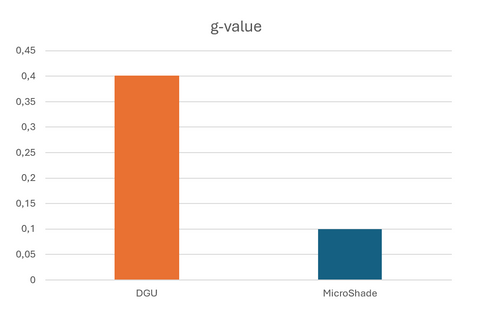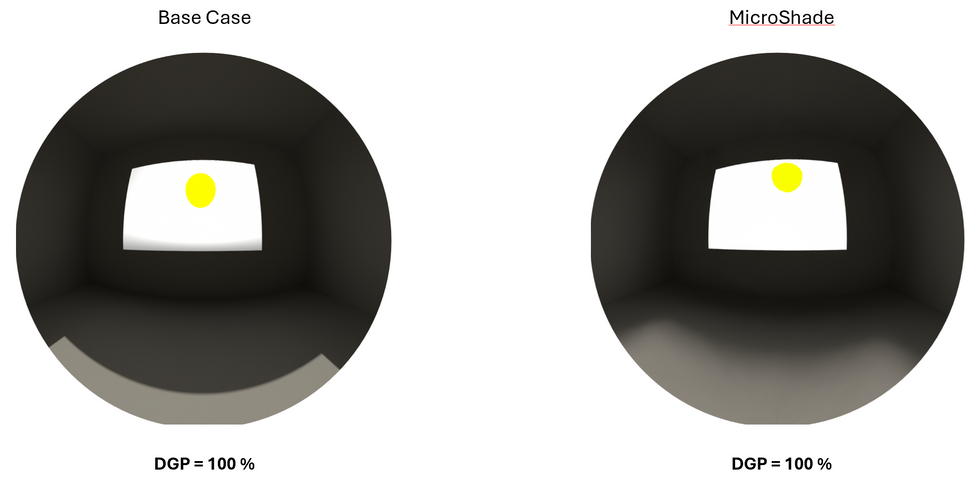Invisible Shading for Glass Facades
- Marius Brun
- Aug 23, 2024
- 11 min read
Updated: Aug 24, 2024
The Issue
Daylight in the workplace is an essential factor for enhancing employee productivity and morale. Adequate natural light can boost mood, reduce eye strain, and improve overall job performance. On the other hand, sunlight and excessive light day levels can lead to glare, headaches and temporary confusion, increasing disruptions and reducing employee productivity. Clearly, facade shading solutions that balance daylight levels and reduce glare are a necessity.
While blinds or curtains can block out the sun, they also eliminate beneficial natural light, making building occupants overly dependent on artificial lighting. In this article, we will review a new and interesting facade shading system that is invisible to the human eye. From an architect's perspective, this product is very interesting, because it allows the use of slick fully glazed facades without compromising the solar shading performance.
Our Approach
For this study, we are examined the new innovative MicroShade solar shading product, which makes use of principle that physical shading systems are scalable without compromising their ability to shade. The MicroShade product is in essence a honeycomb facade shading screen that has been scaled down to a micro level where 1) it becomes invisible to the human eye and 2) it is a shading film that is placed inside the air-gap of a double-glazed window.
Image 1 : Photos of a MicroShade sample (MS-F 60/14) and the enlarged micro-structure sample (Source : IEN Consultants)
In order to better visualise how the MicroShade glazing works, we filmed a time-lapse video in our Kuala Lumpur office:
The video shows significant shading from the MicroShade window sample, evident by the shadows cast on the window sill between 3 and 4 pm. For this video, the glass was placed in a North-West facing window that is exposed to low angle afternoon sun, which will penetrate the MicroShade glazing to some degree. Interestingly, for North and South facing facades in Malaysia, and for other equatorial countries, the MicroShade window product will be able to fully shade direct sun light penetration; refer to the graphs below.
It is said that MicroShade can leave the heat out and ensure plenty of natural daylight and views out. By keeping room temperatures optimal, it allows to reduce the CO2 footprint in the use of cooling and helps improving energy efficiency with a low Solar Heat Gain Coefficient, or g-value of 8-15%. MicroShade is not able to fully prevent glare, especially for low angle sun, but the it has been proven to reduce glare for much of the day.
Image 2 : Comparison of shading devices (left) versus MicroShade (right). Source : MicroShade website
The MicroShade website has an online calculator tool, SimShade, that allows for easy comparison of the technical specifications and annual energy performance of typical double-glazed units (DGU) with MicroShade. For energy analysis of glazing in the tropics, the most relevant glazing parameter is the g-value that denotes the fraction of solar energy that enters the building. The g-value is a coefficient in the range from 0 (no solar heat gain) to 1 (100% solar heat gain). The higher the coefficient is, the higher the solar heat gain. In the hot tropics, we are looking for glazing with a low g-value, in order to reduce solar gain and overheating.
Image 3 : g-value of MicroShade depending on Solar height (degrees above the horizon) and Azimuth (degrees from perpendicular). Source : SimShade
In this article, we study several parameters (illuminance, glare, energy consumption) on a simple shoebox building model with and without MicroShade. The results are obtained by using the IESVE, Rhino (Climate Studio) and SimShade simulation softwares.
Image 4 : Shoebox building model dimensions
Annual hourly simulations were performed to evaluate the energy, daylight autonomy and glare distribution. In addition, for the daylight and glare simulations, we also decided to simulate for two specific points in time:
21 December @ 1pm (SOUTH facing window) The window will be exposed to high angle sun (63 degrees above the horizon)
21 March @ 5pm (WEST facing window) The window will be exposed to low angle sun (35 degrees above the horizon)
For both simulations, the sky condition is set to "sunny skies" (CIE Clear Sky). And the location is Kuala Lumpur, Malaysia, located 3 degrees North of the Equator.
Image 5 : Sun positions versus the window for each orientation, Kuala Lumpur, Malaysia (Source : IESVE)
Our Findings
Our simulation results for daylight, glare and annual solar gain are shown below for both a normal double-glazed window (named "Base Case") and for a double-glazed window with MicroShade mounted inside the air-gap (named "MicroShade") . For the simulated daylighting results, both the average light level (illuminance) and the annual daylight autonomy (sDA) are calculated. For glare assessment, we use the metric of Daylight Glare Probability (DGP). The simulations tools used ClimateStudio (plugin to Rhino), IES and SimShade softwares.
1. RESULTS for SOUTH Facade
A) Daylight level
We simulate the illuminance distribution of daylight coming through the window. Here, the direct sunlight hits the window at a high angle in the sky, namely 63 degrees above the horizon:
Image 6 : Illuminance for Base Case versus MicroShade South window simulated at sun angle (63 degrees above horizon) with Rhino
The above simulations shows that for the normal Base Case window the sunlight passes straight through and hits the floor below the window with the highest illuminance level reaching almost 55,000 lux. In contrast, the MicroShade effectively shades most of the incoming sunlight, reducing the maximum lighting level more than 8-fold with the highest illuminance level only reaching 6,500 lux. Interestingly, this is "worst case" simulation, as the midday solar angle is the lowest on the winter solstice date (21 Dec) for a South facing facade. For the rest of the year, the sun will be higher in the sky or on the other side of the building.
B) Annual Daylight Availability
The Spatial Daylight Autonomy (sDA) is the percentage of the occupied floor area that meets the target illuminance level of 300 lux (using only daylight) for at least 50% of occupied hours (8 am - 6 pm). These annual calculations are based on simulations of different representative sky conditions (sunny, partly overcast, overcast) throughout the year.
Image 7 : Daylight Availability of Base Case versus MicroShade South window simulated with Rhino
At first glance, the sDA simulations above seem to show that the normal window (Base Case) has a significantly higher daylight autonomy (59%) than for the MicroShade window (34%). However, the normal window has excessive daylight levels (Image 6) and considerably more glare issues (Image 8), so realistically, the manual blinds will be engaged on a near permanent basis for the normal Base Case window, hence, significantly reducing its daylight autonomy across the year. In other words, in a real-World scenario where humans engaged the manual blinds to ensure their own visual comfort, the MicroShade window is likely to have the highest daylight autonomy for this 10 meter deep office, simply because the excessive daylight, heat and glare issues are greatly reduced.
C) Glare
a) Daylight Glare Probability (DGP)
The DGP index denotes the percentage of people that will experience visual discomfort due to glare for a orientation and position within a room. For example, people directly facing a window would typically experience more glare than if they face parallel to the window. For ease, the following descriptors are used to describe the level of glare experienced by people:
Imperceptible glare : DGP ≤ 34 %
Perceptible glare : 34 % < DGP ≤ 38 %
Disturbing glare : 38% < DGP ≤ 45 %
Intolerable glare : DGP > 45 %
Glare thresholds:
Glare max 3.5% of the time Glare measurements and surveys performed on a group of students showed the following glare threshold: "Disturbing glare" (aka a Daylight Glare Probability, DGP, between 38 and 45%) should occur for maximum 3.5% of the occupied hours (8 am - 6 pm), according to the "Daylight Handbook II (Daylight Simulations Dynamic Facades)" authored by Christoph Remhart.
Glare max 5% of the time The Spatial Disturbing Glare (sDG) is the percentage of views, across the occupied floor area, that experiences Disturbing or Intolerable Glare (DGP > 38%) for at least 5% of occupied hours (8 am - 6 pm).
b) Spatial Disturbing Glare (sDG)
Annual sDG simulations were done 0.6 x 0.6 meter grid of view points 1.2 meters above the floor. The frequency of glare is represented using eight directional pie slices, coloured to show the frequency of glare for each direction. For a point to be counted as glary under the sDG index, it must experience glare (Disturbing or Intolerable Glare, DGP > 38%) for at least 5% of occupied hours between 8 am - 6 pm:

Image 8 : sDG for Base Case versus MicroShade South window simulated with Rhino
The above annual glare simulation shows a 4-fold lower annual glare frequency (sDG>38/5%) for the MicroShade window (3.3% of floor area) than for the normal window (14.6%). Hence, the room with the MicroShade window will benefit from less use of blinds, higher daylight autonomy and more views out. In other words, the simulations shows that MicroShade greatly reduces the locations within the room where occupants are bothered by glare.
c) Glare 2 meters from facade
A 3D simulation was undertaking for the view and glare a person would experience when seated 2 meters from the facade. Two different seating positions were simulated:
A person facing directly at the window
A person facing parallel to the window
Unlike for the annual sDG glare study, the Daylight Glare Probability (DGP) simulation is evaluated for a precise moment in time, namely at the given date and hour, in this case the 21st December at 1 pm:
Image 9 : DGP for person placed 2 meters from the facade. Directly facing the window (top) and facing parallel to the window (bottom). Simulations done with Rhino.
As expected, the normal Base Case window glare simulation results show a significant reduction in glare, for a person facing parallel to the facade (22%) compared to facing directly at the facade (41%). The validity of the glare simulation results for the MicroShade window is questionable, as they come out virtually identical to those of a normal Base Case window. A plausible reason for this simulation shortfall is that the MicroShade glazing is simulated using a Bidirectional Scattering Distribution Function (BSDF) file, which the glare simulation software might not be able to take into account in the correct manner.
D) Energy Saving
The IESVE software was used to evaluate the annual impact of MicroShade window on the annual energy consumption of an office building in Kuala Lumpur. For this purpose, we build a simple shoebox energy model with the following inputs during the 9 am to 6 pm office hours:
5 W/m² (office equipment)
5 W/m² (lighting)
15 m²/person (occupancy)
2.5 (cooling system COP, coefficient of performance)
South facing facade (room dimensions in Image 4 above).
Heat flows only through facade; all other room surfaces are adiabatic.
The annual energy simulation showed the following daily electricity consumption profile:
Image 10 : Comparison of annual energy consumption of Base Case versus MicroShade South window simulated with IESVE. Note: The graph shows the accumulated energy across the year for each hour. To get the daily consumption, divide by the number of days (365) per year.
The energy simulations shows that installing a 2 x 3 meter MicroShade window saves 296.3 kWh of electricity per year.
2. RESULTS for WEST Facade
In this section, we rotated the model in order to have it facing West, and re-run all the simulation analyses. For the point in time daylight and glare analysis, 21 March @ 5 pm, the sun is directly facing the windows at a solar height of 35 degrees above the horizon (see image 3). In other words, this West facing window will have more directly sunlight exposure and low angles and the MicroShade is therefore expected to perform less well than for the South oriented window. Let's see...
A) Daylight Level
For this case, the MicroShade window only reduces the maximum light level 2-fold compared to the normal Base Case window, namely from 38,000 lux (Base Case) to 22,000 lux (MicroShade). As expected, the MicroShade is less effective in reducing direct sun penetration for lower incident direct sunlight angles (35 degress above the horizon):

Image 11 : Illuminance for Base Case versus MicroShade West window simulated with Rhino for low sun angle (35 degrees above horizon)
B) Annual Daylight Availability
We found the same results for annual Spatial Daylight Autonomy (sDA) whether the facade is facing South or West. Whereas the MicroShade window effectively can block direct sunlight entry for South-facing windows, it is unable to do so for West-facing windows with low incident afternoon sun.

Image 12 : Daylight Availability for Base Case versus MicroShade West facing windows simulated with Rhino
The above simulation simulation results can largely be disregarded due to the fact that both the Base Case and the MicroShade West facing windows will frequently will be exposed to direct sunlight entry in the afternoons, and as a result the room occupants are expected to engage the blinds on a near permanent basis, which will significantly reduce the daylight autonomy to levels much lower that the sDA figures stated above.
C) Glare
a) Spatial Disturbing Glare (sDG)
The West facing window has a major glare issue, both for the Base Case and for the MicroShade window, because none of the window types are able to effectively block low angle sun:

Image 13 : sDG for Base Case versus MicroShade windows facing West simulated with Rhino
The annual glare analysis above shows that both cases experience high levels of glare stretching at least 1/3 into the room. As a result, manual blinds are likely to be engaged on a near permanent basis.
b) DGP seated at 2 meters
Image 14 : DGP for Base Case versus MicroShade West facing window for person facing window directly (top) and facing parallel to window (buttom) simulated with Rhino.
Here, we obtain the same glare conclusions for the South facing window, namely that sitting parallel to the facade is better than facing the facade directly. Moreover, the simulations results seem to indicate that this type of glare simulation is not giving correct results for daylight systems simulated with Bidirectional Scattering Distribution Function (BSDF) files, which was done for the MicroShade window.
D) Energy Saving Apart for the energy model orientation switching from South to West, the IESVE energy simulation inputs are identical (see above).
Image 15 : Comparison of annual electricity consumption for Base Case versus the MicroShade West facing window using the IESVE. Note: The graph shows the accumulated energy across the year for each hour. To get the daily consumption, divide by the number of days (365) per year. software
The energy simulation the 2 x 3 meter MicroShade West window can save 389.2 kWh electricity per year compared to using a normal Base Building DGU window.
Outcomes
This study demonstrates the effectiveness of MicroShade as an innovative effective solution for managing solar heat gain and glare in office environments, especially for North and South facing facades, which in the tropics are exposed entirely to high angle direct sunlight. The simulations were conducted using the Rhino (Climate Studio), IESVE and SimShade softwares, and provided compelling evidence that MicroShade can significantly enhance workplace visual comfort and energy efficiency.
Key Findings :
Illuminance Control : MicroShade effectively reduces excessive sunlight for South and North facade while maintaining sufficient natural light levels within the workspace. The simulation showed that MicroShade achieved a factor 8 reduction in peak indoor daylight levels, hence, greatly limiting issues related to overexposure to sunlight, such as glare and overheating, which are common in offices with large windows.
Glare Reduction : MicroShade is most successful in reducing glare for North and South facades, where a 4-fold drop in the annual Spatial Disturbing Glare (sDG) was found. In other words, a four times smaller floor area where occupants are subjected to disturbing or intolerable glare. As a consequence, MicroShade improves "enlarges" the useful floor area in the facade perimeter zone by enhancing the visual quality, ensuring a view out, daylight, and reducing the need of the manual window blinds. And as a consequence, MicroShade helps to enhancing workplace productivity and well-being.
Daylight Availability : Although MicroShade slightly reduces daylight availability towards the back of the room, the product still provides ample natural light near the window, ensuring a pleasant working environment that greatly reduces the need to engage the manual blinds, hence, ensuring a high daylight autonomy compared to normal windows, where blinds will likely be engaged on a near permanent basis.
Energy Efficiency : The MicroShade shading system also helps to reduce the annual electricity consumption for cooling by reducing the solar heat gain coefficient.
Conclusion
MicroShade is an interesting new shading solution for office towers in the tropics and beyond, expecially for architects that insist on clean and slick glazed facades without any exterior shading elements. The MicroShade delivers the shading performance of a honeycomb facade screen that has been greatly shrunk to fit inside the air-gap of a double-glazed facade. The honeycomb structure of MicroShade is so small that it is not visible to the human eye and appears to be perfectly transparent. Our analysis shows that MicroShade performs best for North and South facing facade, where it can block almost all direct sunlight from entering.
References & acknowledgements:
Glare thresholds referenced from the book "Daylight Handbook II (Daylight Simulations Dynamic Facades)" authored by Christoph Remhart.
Simon Laporte, assisted with the daylight simulations
Gregers Reimann, contributor to the article
























